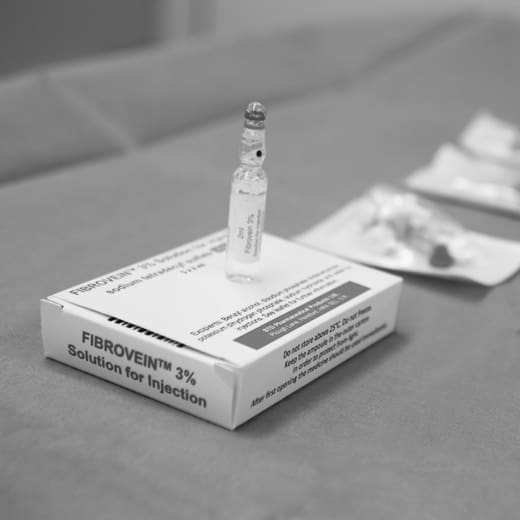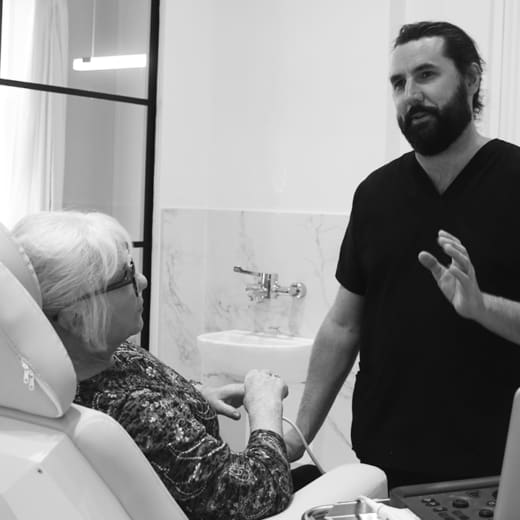McKeown Medical
167 Bath Street, Glasgow, G2 4SQ
Foam sclerotherapy is a minimally invasive treatment for varicose veins and spider veins. It involves injecting a specialised foam solution into the affected vein, causing it to collapse and eventually be absorbed by the body.
Foam sclerotherapy is a minimally invasive treatment for varicose veins and spider veins. It involves injecting a specialised foam solution into the affected vein, causing it to collapse and eventually be absorbed by the body.
Every patient is unique, and during our consultation process, we work with you to develop a bespoke treatment plan based on what you want to achieve.
1 hour
Local
Typically none
Long term
From £900
Foam sclerotherapy is particularly effective for treating smaller varicose veins that are not suitable for or don’t fully respond to treatment with radiofrequency ablation (RFA) or VenaSeal™. Foam sclerotherapy is usually employed as an adjunct to RFA or VenaSeal™ procedure to take care of smaller vessels that don’t respond to the bigger treatments. Rarely, it can be used as a first line treatment – although using it in high volumes to treat large veins is associated with a higher risk of deep vein thrombosis, which is why we reserve its use for only small residual veins rather than as a primary treatment for varicose veins.
The foam is composed of sodium teradecyl suphate (STS) and air. The STS diplaces blood and removes the “non-stick” inner lining of the injected vein. This causes the abnormal vein to clot and become blocked thus rerouting blood flow to healthier veins. The treated veins become firm and lumpy and over time are reabsorbed by the body.
After the injection, compression bandages or stockings are applied to the treated area to help collapse the vein and reduce swelling. Compression helps to keep the treated vein closed and promotes healing.
Dr Alex Vesey is our expert consultant vascular surgeon who heads up our varicose vein team. Listen to him explain the foam sclerotherapy treatment for varicose veins.
Finding the right treatment for you is the most important factor in ensuring that you are on the correct path to achieve the results you desire. Our pre-consultation form helps us to identify your needs and, ultimately, gets you on the right path to achieving your optimal results.

We believe in clear, transparent pricing. We have no vague ‘from’ prices, that suddenly increase after your consultation. The prices here are accurate and reflect what you will pay for our level of expertise, technology and service.
Patients are usually advised to wear compression stockings for several days to weeks after the procedure to support vein closure and reduce swelling. Light walking is encouraged soon after the procedure to promote circulation, but strenuous activities and prolonged standing should be avoided for a short period.
Because the foam essentially acts to destroy the inside of the vein so that the vein is reabsorbed by the body, it typically takes a while for this to happen. Initially the treated veins will be hard and lumpy and it usually takes 2-3 months to see the full results.
Additional sessions may be needed for optimal results, especially if multiple or large veins are treated. Most patients will need between 1 and 3 sessions of foam injection, depending on their circumstances.
The risks associated with small amounts of foam injection are low and the procedure is characterised by a high degree of safety. Some bruising, localised lumpiness and tenderness are to be expected following the treatment. Significant inflammation of the blood vessels (thrombophlebitis) occurs in 5% of patients. Permanent marking of skin (usually a bluish or reddish patch at the site of injection can affect between 10-30% of patients. An area of superficial skin necrosis (skin ulcer) can occurs rarely. There is also a very small risk of stroke (1 in 10,000 patients) if you happen to have an undiagnosed hole in the heart. Very rarely, it’s possible to have a serious allergic reaction to the foam. Deep vein thrombosis affects approximately 1 in 100 (1%) patients. This requires immediate medical attention to prevent it from progressing to a pulmonary embolism.
As always, the key to achieving the best outcome is to ensure you are treated by a fully qualified and experienced vascular surgery specialist. Make sure you feel you have a relationship you can trust with your doctor and follow their guidance on the best treatment options for you, including all of their aftercare instructions.
The risk of recurrence is around 20% following foam sclerotherapy. It is also possible to develop new varicose veins after the initial treatment, so it’s sometimes necessary to repeat the treatment.

Our vascular surgery service is led by Dr Alex Vesey. Alex is a highly skilled vascular surgeon with extensive experience in diagnosing and treating a wide range of vascular conditions. With a focus on minimally invasive techniques, Dr. Vesey is dedicated to providing patients with the most advanced and effective treatments for venous diseases, with a particular interest in the treatment of varicose veins.

Our vascular surgery service is led by Dr Alex Vesey. Alex is a highly skilled vascular surgeon with extensive experience in diagnosing and treating a wide range of vascular conditions. With a focus on minimally invasive techniques, Dr. Vesey is dedicated to providing patients with the most advanced and effective treatments for venous diseases, with a particular interest in the treatment of varicose veins.
We offer a full range of treatments for varicose veins, each one tailored to your own unique circumstances.

Foam sclerotherapy is an advanced form of sclerotherapy used to treat larger varicose veins, particularly those that may not respond...

Varicose veins are enlarged, twisted veins that often appear just under the skin, primarily in the legs and feet.
1 / 3
2 / 3
3 / 3

Foam sclerotherapy is an advanced form of sclerotherapy used to treat larger varicose veins, particularly those that may not respond...

Varicose veins are enlarged, twisted veins that often appear just under the skin, primarily in the legs and feet.
Keep up to date with the latest news from McKeown Medical and get access to expert insights, our latest before and afters and exclusive offers.

